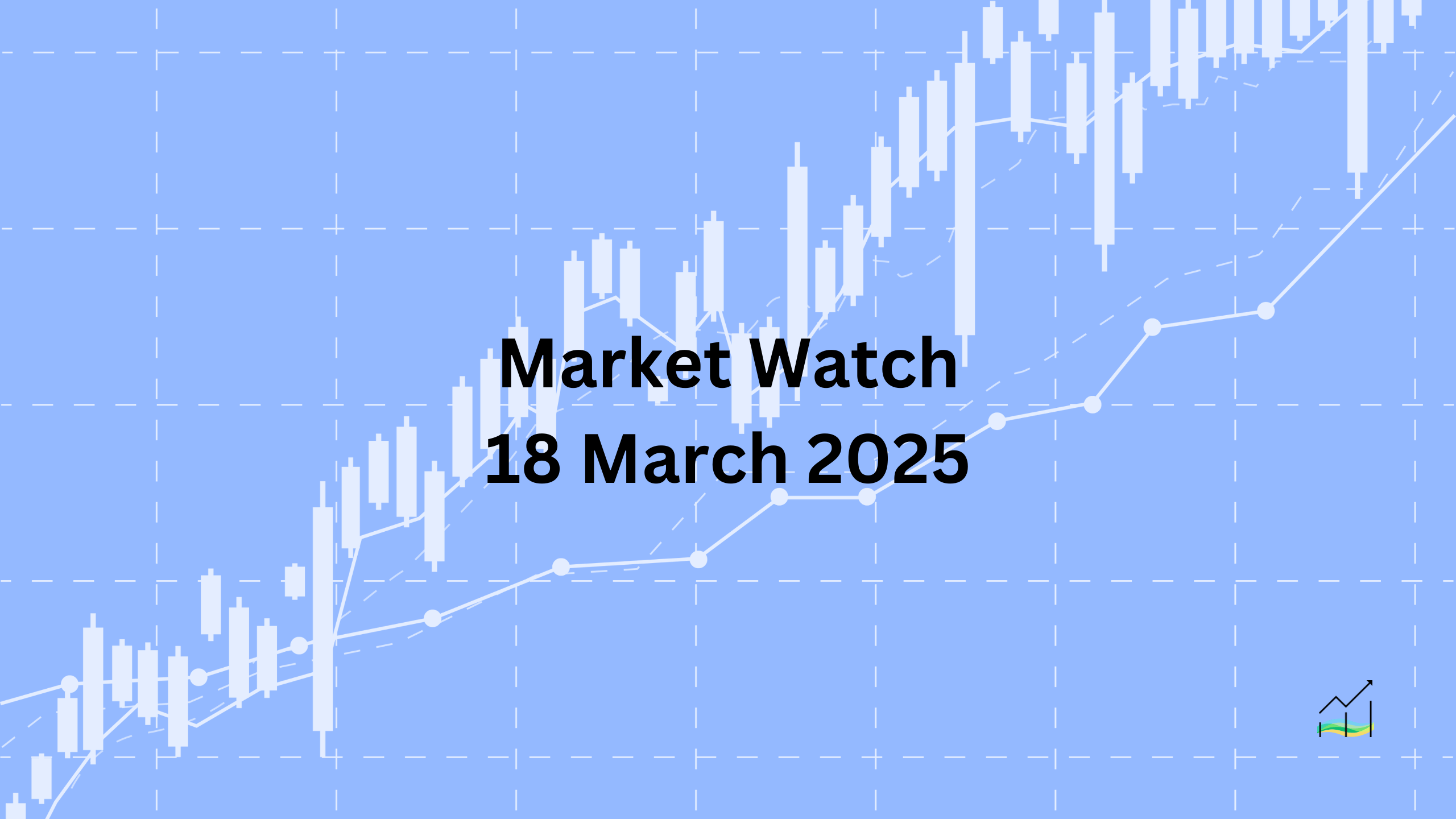18/03/2025 Market Watch

Greenback Weakens, Global Equities Rally & Gold Hits Record High
The US dollar continues to face pressure, reaching new lows against the euro and the British pound. It remains weaker against most G10 currencies except the Japanese yen, which has been affected by disappointing economic data and political turmoil. Prime Minister Ishida’s admission of distributing cash to lawmakers has caused a sharp drop in his approval ratings, creating a challenging environment for the upcoming upper house election. Meanwhile, most emerging market currencies are strengthening.
Global equities are seeing gains, fueled by a recovery in US stock indices. In the Asia-Pacific region, stocks rallied, with Hong Kong’s mainland shares index jumping nearly 2.8% following the unveiling of a new rapid charging system by BYD for electric vehicles. The index has surged almost 26% in the first quarter. Japanese markets also gained over 1%, while Europe’s Stoxx 600 climbed about 0.75%, marking its third consecutive day of gains—the longest streak in over a month. US index futures are slightly weaker.
In the bond market, European benchmark 10-year yields are edging up by 2-3 basis points ahead of a German vote on fiscal initiatives. US 10-year Treasury yields are also rising, nearing 4.32%, approaching last week’s high of 4.35%.
Gold is extending its rally, reaching a new record high of approximately $3,028.50, after hitting a low near $2,880 last week. Meanwhile, oil prices are climbing as geopolitical tensions intensify. With Israel increasing its military actions and the US targeting Houthi positions, May WTI crude oil has risen by over $1 per barrel, surpassing its 20-day moving average of $68.15 for the first time in nearly a month.
United States of America
Overview
The US Dollar Index is under pressure, testing the 103.20 level, its lowest since mid-October 2024. Despite stretched momentum indicators, a recovery above 104.00 is needed to ease downside pressure. The selling pressure appears strongest in Europe, as investors unwind last year’s record US equity purchases. A drop below 103.00 could pave the way for a further decline toward 102.00.
Economic Drivers
Several factors are influencing the dollar’s weakness:
- Investor Sentiment: After heavy US equity purchases last year, investors are shifting away from US assets, selling both stocks and the dollar.
- Recession Concerns: Economic risks remain, with growing fears of a slowdown.
- Technical Levels: The Dollar Index faces critical resistance at 104.00, while a break below 103.00 could lead to further losses.
Data and Events
Upcoming US economic reports may provide clarity on economic conditions:
- Housing Starts & Permits – A key indicator of real estate sector health.
- Industrial Production – A measure of economic activity, crucial in assessing growth prospects.
- Import & Export Prices – Forecasts suggest a decline, which could impact inflation expectations.
- FOMC Meeting Conclusion – Markets are watching for signals on future monetary policy.
Price Action
The Dollar Index remains under pressure, struggling to gain traction above 103.20. If it fails to recover above 104.00, further downside toward 102.00 is likely. Meanwhile, investors remain cautious ahead of economic data releases and the Fed’s policy signals.
Key Points:
- The Dollar Index is testing its lowest level since October 2024.
- Investors are selling US equities and the dollar after last year’s record buying.
- A break below 103.00 could lead to further declines toward 102.00.
- Economic data, including housing and industrial output, may influence sentiment.
- The FOMC meeting outcome remains a key focus for markets.
Australia
Overview
The Australian dollar climbed to a monthly high of $0.6390 and is holding its gains. The currency is consolidating, with key resistance near $0.6410, the high from February 21. A break above $0.6415 would mark a significant retracement of last year’s decline. Traders are also watching for the expiration of A$1.1 billion in options at $0.6400-$0.6410 on Thursday.
Economic Drivers
Several factors are influencing the Australian dollar’s movement:
- Technical Resistance: The currency faces key levels at $0.6410 and $0.6415, marking important retracement points.
- Employment Data Impact: February’s employment report, due Thursday, could drive market sentiment.
- Cyclone Alfred’s Economic Impact: Australia’s Treasurer Chalmers warned that the cyclone could reduce quarterly GDP by 0.25%, with losses of 12 million work hours and 44,000 insurance claims.
Data and Events
Key upcoming events that could impact the Australian dollar:
- February Employment Data (Thursday) – A major market-moving report that could influence interest rate expectations.
- Treasurer Chalmers’ Speech (March 25) – Expected to provide insights into economic risks and recovery plans.
- Options Expiry (Thursday) – A$1.1 billion in options at $0.6400-$0.6410 could affect short-term price action.
Price Action
The Australian dollar remains strong, consolidating near $0.6390. A breakout above $0.6410-$0.6415 could trigger further upside, while downside risks remain if economic data disappoints.
Key Points:
- The Australian dollar hit a new monthly high of $0.6390 and is consolidating.
- Resistance levels to watch: $0.6410 and $0.6415.
- February’s employment report is a major focus for traders.
- Cyclone Alfred may impact GDP by 0.25%, affecting economic growth.
- A$1.1 billion in options at $0.6400-$0.6410 expire on Thursday.
Canada
Overview
The US dollar extended its decline against the Canadian dollar, falling to CAD1.4275, breaking last week’s low. It also settled below the 20-day moving average (CAD1.4345) for the first time in three weeks. The next key support level is near the month’s low at CAD1.4240, with further downside potential toward last month’s low at CAD1.4150.
Economic Drivers
Several factors are influencing the movement of the US dollar against the Canadian dollar:
- Technical Weakness: The US dollar has broken key support levels, signaling potential further downside.
- Inflation Expectations: The end of Canada’s tax holiday and higher gasoline prices are expected to push inflation higher.
- Rate Cut Probability: Markets are pricing in less than a 40% chance of a rate cut next month but see an 85% likelihood of a cut by June.
Data and Events
Key developments that could impact the Canadian dollar:
- February CPI Report (Today) – Inflation is expected to rise 0.6% month-over-month, lifting the annual rate to 2.2% from 1.9%.
- Core Inflation Measures – Likely to remain steady, offering insight into broader inflation trends.
- Swaps Market Pricing – Traders are adjusting expectations for rate cuts in the coming months.
Price Action
The US dollar remains under pressure, holding near its recent lows. A break below CAD1.4240 could open the door for a move toward CAD1.4150. Resistance is now seen at CAD1.4345, the 20-day moving average. The inflation report will be a key driver of near-term movement.
Key Points:
- The US dollar dropped to CAD1.4275, breaking below key support levels.
- It settled under the 20-day moving average for the first time in three weeks.
- Canada’s inflation is expected to rise due to tax policy changes and higher gasoline prices.
- Markets see a high probability of a rate cut by June.
- A move below CAD1.4240 could lead to further declines toward CAD1.4150.
China
Overview
The US dollar remains under pressure against the offshore yuan (CNH), hovering just above CNH7.2150. It briefly dipped below the 200-day moving average (CNH7.2215) but remains below the 20-day moving average (CNH7.2550). Against the onshore yuan (CNY), the dollar is fluctuating between key moving averages at CNY7.2175 and CNY7.2335. The People's Bank of China (PBOC) continues to adjust the dollar’s reference rate, setting it at CNY7.1733 today after last week's CNY7.1738.
Economic Drivers
Several factors are shaping the movement of the US dollar against the yuan:
- Central Bank Policy: The PBOC adjusted the reference rate to its lowest since November, indicating a controlled approach to currency stability.
- Loan Prime Rates Decision: China is set to determine loan prime rates and the one-year medium-term lending facility rate this week, though no changes are expected.
- Geopolitical Tensions: Beijing is scrutinizing Hong Kong’s CK Hutchinson’s $19 billion deal with BlackRock involving 43 ports, including key locations near the Panama Canal. It remains unclear whether regulatory approval will be granted.
Data and Events
Key developments to watch this week:
- PBOC Reference Rate Adjustments – A shift in the dollar’s reference rate could signal China’s stance on currency movements.
- Loan Prime Rate & Lending Facility Decision – Expected to remain unchanged but could influence market sentiment.
- Regulatory Review of CK Hutchinson’s Deal – China’s decision could impact trade and investment flows.
Price Action
The US dollar is holding near CNH7.2150, struggling to reclaim the 200-day moving average at CNH7.2215. Against the onshore yuan, it is confined between key support at CNY7.2175 and resistance at CNY7.2335. The PBOC’s rate adjustments and regulatory decisions could drive further volatility.
Key Points:
- The US dollar remains under pressure against the yuan, testing key technical levels.
- The PBOC set the dollar’s reference rate at its lowest since November.
- China is expected to keep loan prime rates and lending facility rates unchanged.
- Beijing is reviewing a major $19 billion port deal, adding uncertainty to trade flows.
- A break below CNH7.2150 could signal further weakness, while resistance is at CNH7.2550.
Europe
Overview
The euro has extended its gains, reaching a five-month high of approximately $1.0955. It has not traded below $1.08 since March 7, and the next upside target is around $1.10. Improving German investor and consumer sentiment, along with a newly agreed fiscal policy, is supporting the euro’s strength.
Economic Drivers
Several key factors are driving the euro’s recent appreciation:
- German Fiscal Policy: A political compromise last week paved the way for new fiscal initiatives, boosting confidence.
- Improving Sentiment: Even before the policy agreement, investor and consumer sentiment in Germany was on an upward trend.
- ZEW Survey Results:
- The current assessment index improved to -87.6 in March from -88.5 in February, its best level since October.
- The expectations index surged to 51.6 in March from 26.0 in February, marking its highest level since February 2022 and the first consecutive monthly gain since mid-2023.
Data and Events
Key developments influencing the euro:
- German Fiscal Policy Vote (Today) – Expected to formalize the political agreement from last week.
- ZEW Economic Sentiment Survey – Showed improving confidence in both current conditions and future expectations.
- Upcoming Inflation and Growth Data – Markets will watch for further signs of economic recovery in Germany and the Eurozone.
Price Action
The euro remains strong, with $1.0955 marking a fresh five-month high. A continued upward move could see a test of $1.10, while support remains near $1.08. Market sentiment and upcoming economic data will play a key role in determining the next move.
Key Points:
- The euro reached a five-month high of around $1.0955, with $1.10 as the next target.
- German sentiment has been improving since early 2024, reinforced by fiscal policy developments.
- The ZEW expectations index posted its highest reading since February 2022.
- Today’s German fiscal policy vote is expected to solidify recent market optimism.
- Support for the euro is at $1.08, while resistance is near $1.10.
Japan
Overview
The US dollar is nearing JPY150, a level it has not breached in nearly two weeks. It recently rebounded from a five-and-a-half-month low of JPY146.55 set last Monday and settled above its 20-day moving average (JPY149.20) for the first time since mid-January. This level is more than just psychological resistance, as nearly $1.5 billion in options are set to expire there today.
Economic Drivers
Several factors are influencing the dollar-yen exchange rate:
- Technical Levels: The US dollar has broken above key moving averages, signaling potential further upside.
- Japanese Economic Data:
- The tertiary industry index (services) declined by 0.3% in January after a revised 0.4% gain in December.
- Industrial production fell by 1.1% in January, marking the third consecutive monthly decline.
- Growth Expectations: The Japanese economy is projected to grow at an annualized rate of 0.4% in Q1, following a 2.2% expansion in Q4 2024.
Data and Events
Key developments to watch:
- Bank of Japan Policy Meeting (Tomorrow) – No policy changes are expected.
- US Dollar Option Expiry (Today) – Nearly $1.5 billion in options at JPY150 could impact price movements.
- Future Rate Hike Possibilities – The swaps market indicates a 50% probability of a BOJ rate hike in June.
Price Action
The US dollar remains in an upward trend, approaching the JPY150 resistance level. If it breaks above this level, further gains could be expected. Support is now seen at JPY149.20, while downside risks remain if the BOJ signals a more hawkish stance.
Key Points:
- The US dollar is testing JPY150 after recovering from a multi-month low.
- Japan’s economy is projected to grow at 0.4% in Q1, following a strong Q4.
- Industrial production has declined for three straight months.
- The BOJ is expected to maintain its policy stance in tomorrow’s meeting.
- Market pricing suggests a 50% chance of a BOJ rate hike by June.
United Kingdom
Overview
Sterling briefly rose above $1.30 in early European trading but failed to hold gains, encountering resistance that extends toward $1.3050. This marks the first test of these levels since November 7. The rejection of higher prices suggests a potential bearish divergence in short-term momentum indicators, with initial support around $1.2960-$1.2970.
Economic Drivers
Several factors are shaping the movement of the British pound:
- Bank of England Policy Expectations: The BOE is widely expected to keep interest rates unchanged this week, but markets are pricing in a 75% chance of a rate cut by May.
- Labor Market Stability: Wage growth is expected to remain steady, while the unemployment rate is projected to hold at 4.4%.
- Macroeconomic Outlook: A stable labor market and resilient economic indicators could delay rate cuts, while signs of weakness might increase expectations for earlier easing.
Data and Events
Key upcoming events to watch:
- UK Labor Market Report (Thursday) – Expected to confirm stable wage growth and an unemployment rate of 4.4%.
- Bank of England Meeting (Thursday) – Policy decision and forward guidance could shape interest rate expectations.
Price Action
Sterling’s attempt to break $1.30 was short-lived, facing strong resistance near $1.3050. The rejection has raised concerns of a potential pullback, with initial support at $1.2960-$1.2970. Traders remain cautious ahead of key UK economic data and the BOE’s policy announcement.
Key Points:
- Sterling briefly touched $1.30 but failed to hold gains.
- Resistance extends toward $1.3050, with initial support at $1.2960-$1.2970.
- UK labor market data and the BOE meeting on Thursday could influence direction.
- The BOE is expected to keep rates unchanged, but markets see a 75% chance of a rate cut by May.
- Bearish divergence in intraday momentum suggests a potential pullback.
© 2025 SKONE Enterprise (003319453-V). All rights reserved.
The content on this site is for informational purposes only and does not constitute financial advice.


